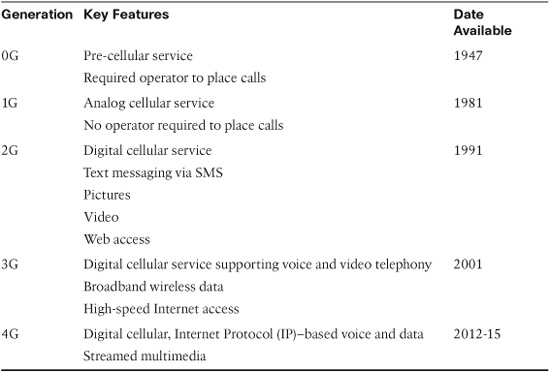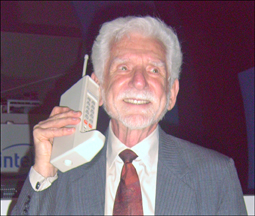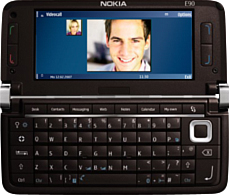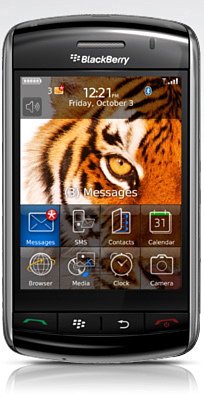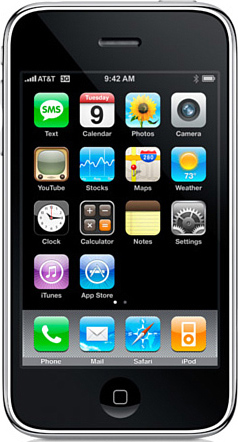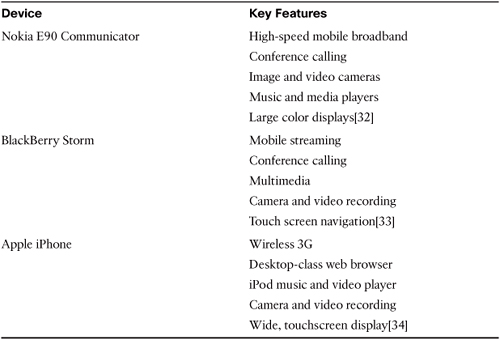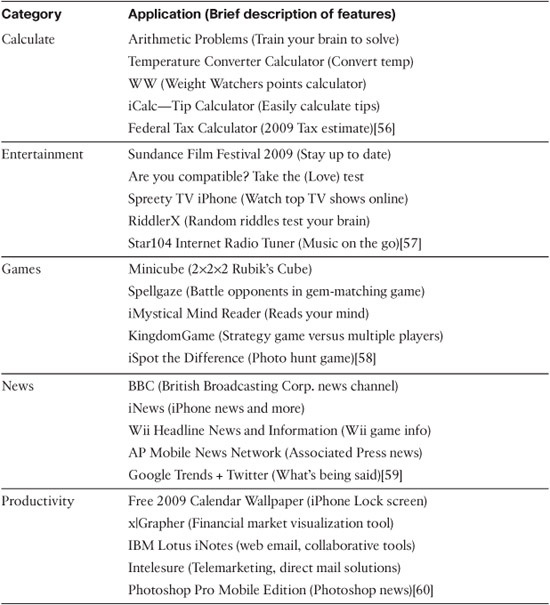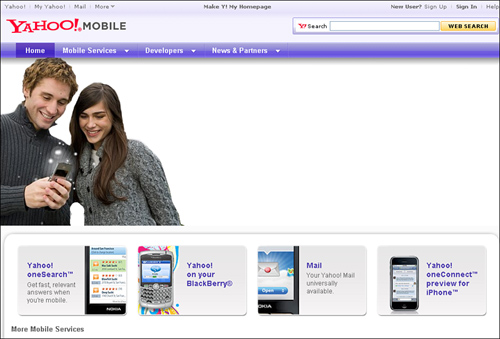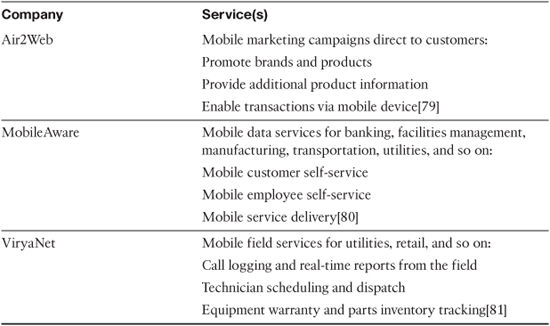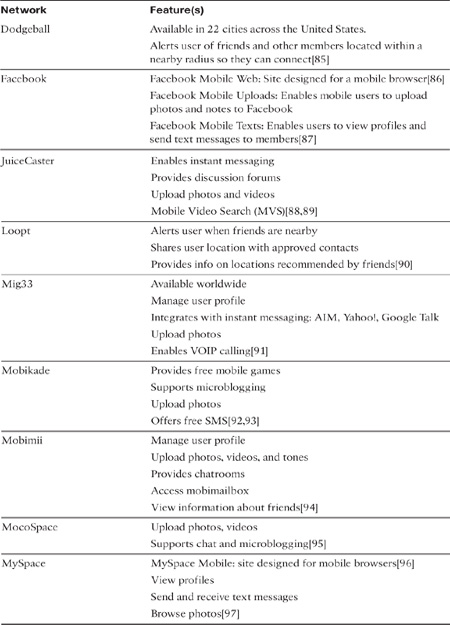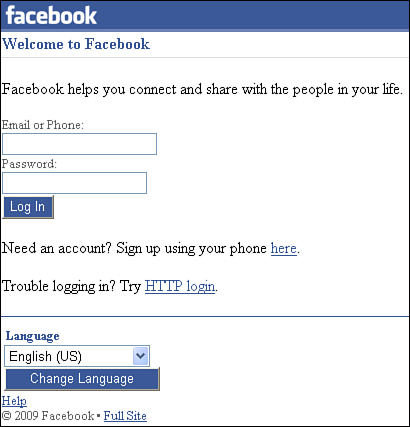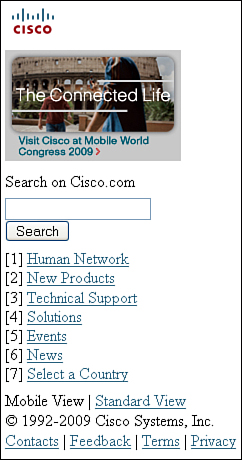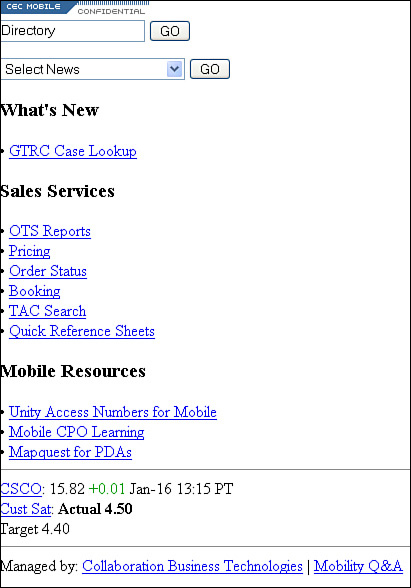CHAPTER 9. Web 2.0 and Mobility
<monologue>
Mobile devices with web access extend the ubiquity of the Internet, offering anywhere, anytime access to information. This makes it possible to share information with colleagues and friends through photo and video media, as well as by voice. Consumers can quickly capture photos and videos with cameras embedded in their mobile devices and share them with relatives and friend via email or post them to MySpace or YouTube.
The power of this new, faster, richer, Mobile Web connectedness is evident from the impact the Mobile Web has brought to bear during recent disasters. During these events, Mobile Web users kept the world informed through user-generated content: breaking news and actual first-hand photos and videos from the scene. Web 2.0 and mobility and the connectedness they enable offer each enterprise the opportunity to transform and accelerate business processes and achieve employee productivity gains as well.
</monologue>
Access the web over a wireless network via a mobile device such as a handheld computer, personal digital assistant (PDA), or browser-enabled smartphone, and you’re on the Mobile Web.[1] It’s important because if analysts’ predictions are correct, the Mobile Web will experience phenomenal growth and forever change the way the world does business. So this chapter
• Briefly describes the evolution of Mobile Web technology
• Examines the generations of mobile phone services
• Touches on a number of mobile devices—the very first as well as the very latest—and key features such as voice recognition and position location
• Identifies some of the platforms used for developing Mobile Web applications
• Provides examples of the types of Mobile Web applications and services available today
• Describes how mobile devices are used in social networking
• Identifies Cisco’s efforts to create Mobile Web applications
• Discusses some of the mobile information services being used by Cisco Sales
• Identifies the impact these applications are having on these business users
More importantly, the chapter provides insight into the business value of the Mobile Web.
Mobility provides an opportunity for enterprises to transform and accelerate business processes and increase employee productivity, particularly in a Web 2.0 world. Many enterprises such as Cisco have built out their mobile infrastructure and deployed mobile devices to their employees, particularly in sales and support. As enterprises develop new or modify existing applications, both internally and externally facing, they are doing so with web access—particularly Mobile Web access—in mind to take full advantage of Mobile Web technology.
Mobility, for example, provides immediate access to information and data enriched with context such as geoposition. Equipment location can be plotted on a map on a company website, a “webmap.” With a web-enabled mobile device, a service technician can be notified immediately of an equipment failure, find the location on the webmap, find, connect, and share photos and videos of malfunctioning equipment with colleagues for a collaborative diagnosis, or research potential, innovative, user-generated content: problems and solutions shared on the web.
With access to the appropriate enterprise applications and websites, the technician can quickly and easily connect to order a part or loaner equipment, update the trouble ticket, and notify a customer that the problem is being solved. That’s the power of the Mobile Web. As Mobile Web technology evolves, organizations need to understand and foster its application to fully realize the business transformation, process acceleration, and employee and customer connectedness it enables.
Evolution of Mobile Web Technology
This section provides a brief overview of the evolution of Mobile Web technology, outlining the generations of mobile technology. The section goes on to explore several types of mobile devices, the first and the very latest. Included is a discussion of some key features available on mobile devices today: voice recognition and position location. This will serve as a foundation for your exploration of Mobile Web applications and websites available today.
Generations of Mobile Phone Technology
AT&T introduced Mobile Telephone Service (MTS) in the United States in 1946. Weighing 76 lbs., the first mobile phone worked like a walkie-talkie, with one person speaking at a time and a push-to-talk button on the handset controlling the direction of the call.[2] Communications researchers came up with the idea of dividing large mobile telephone service areas into smaller “cells,” enabling service providers to reuse radio frequencies within each cell and thereby increase the number of calls that could be handled by each cell.
In 1947, after AT&T first proposed the idea, the Federal Communication Commission limited the number of radio frequencies for mobile telephones. This continued until 1968, when AT&T proposed, and the FCC approved, a cellular system of small, low-powered cell towers. Each “cell” covered a smaller area and calls passed from tower to tower as the phone moved past them.[3]
Mobile phone (also known as wireless telephone) technology is usually divided into generations. The first mobile phone service, described previously, began after World War II. Commonly referred to as 0G, it preceded cellular phone service, offered only a few channels, and required an operator’s help to place a call. The first generation of wireless cellular communication technology, called Analog Mobile Phone Service (AMPS) is known as 1G. Introduced in 1981, it enabled users to place calls without an operator and used analog radio signals to pass calls between cells.[4]
Second-generation technology (2G) introduced digital cellular in 1991, enabling data services, including the ability to send and receive pictures and video.[5] Digital also enabled access to webpages written in Wireless Markup Language (WML) via a browser, based on Wireless Application Protocol (WAP).[6] Currently, the most popular standard for digital services, Global System for Mobile Communication (GSM), got its start in Europe, where it was originally called Groupe Spécial Mobile. GSM introduced an alternative to voice calls: short alphanumeric text messaging via a protocol called Short Message Service (SMS).[7]
Subsequent generations offer even more data services. Enhanced Data Rates for GSM Evolution (EDGE), for example, is a mobile phone technology deployed in North America and often referred to as 2.75G. It enables faster data transmission on top of GSM.[8] Third-generation technology (3G), introduced in 2001, offers wide-area wireless voice and video telephony, as well as broadband wireless data access, and is faster than EDGE. 3G networks should not be confused with short-range wireless data networks, which are based on the IEEE 802.11 standard and commonly known as Wi-Fi or wireless local area network (WLAN).[9] Newer mobile devices can often connect to the web via one or more of these networks for data access.
Many newer devices can connect to other devices, such as headsets, via Bluetooth, a wireless protocol that enables data exchange over short distance.[10] In addition, satellite phones can connect to orbiting satellites and are often used in remote areas without access to terrestrial networks and cell towers.[11] Finally, 4G, or fourth generation, is expected to provide faster, higher-quality services, including Internet Protocol (IP)-based voice, data, and multimedia. This will require complete replacement of existing networks and, as Table 9-1 indicates, will probably occur around 2012-15.[12]
Table 9-1 Generations of Mobile Technology
Now take a brief look at various types of mobile devices designed to take advantage of these services.
Mobile Devices
Mobile devices have changed significantly since April 1973, when Dr. Martin Cooper placed the first public call on a 30-ounce portable, brick-shaped cellular phone, shown in Figure 9-1.[13]
Figure 9-1 Martin Cooper uses first portable cellular phone.[13]
In the beginning, cell phones were used primarily to make calls, and personal digital assistants (PDA) were developed as handheld devices to store memos, addresses, and phone numbers. In 1983 Casio introduced the first PDA, the PF-3000, shown in Figure 9-2.
Figure 9-2 Casio PF-3000, the first personal digital assistant (PDA).[14]
Subsequent PDAs, like the Pilot 5000 introduced by Palm in 1998, provided a touch-sensitive screen and the capability to synchronize calendar and contacts with the user’s personal computer.[15] As cell phone designers added features found on PDAs, the smartphone was born.[16] Figure 9-3 shows Simon, the first smartphone, a touch-sensitive device developed by IBM and sold in 1994.[17] Nokia introduced one of the world’s bestselling smartphones, the 9000 Communicator shown in Figure 9-4, in 1996.[18]
Figure 9-3 Simon, the first smartphone, developed by IBM.[17]
Figure 9-4 Nokia 9000 Communicator.[19]
Today, many mobile devices have a number of features, including an operating system, enabling them to run applications like small computers. Most are pocket-sized, have a miniature QWERTY keyboard to facilitate text messaging, and use a color display screen. Many devices, as noted previously, can connect to the web for data access via one or more of the cellular or wireless networks.
Some devices use voice recognition technology, location-based services, and device synchronization to increase ease of use.[20] Cameras are a popular feature for capturing photos and videos on the go and sending them to family and friends or uploading them to the web. At the start of 2008, Nokia held 40% of the world’s mobile phone market, shipping more devices in the last quarter of 2007 than the next three largest vendors, Samsung, Motorola, and Sony Ericsson, combined.[21] Figure 9-5 shows the Nokia E90 Communicator, one of the most popular Nokia devices in 2007.[22]
Figure 9-5 Nokia E90 Communicator.[23]
Figure 9-6 displays the BlackBerry Storm, the newest device from Research in Motion (RIM), released in November 2008.[24] The BlackBerry has been a popular business device and the Storm offers features sure to please business users, including the ability to open and edit Microsoft Word documents and Excel spreadsheets and view PowerPoint presentations.[25] But RIM hopes the Storm will be popular with consumers as well, thanks to its touchscreen and multimedia capabilities.[26] The Storm offers a clickable touchscreen and virtual mouse pointer that enable the user to point, cut, and copy screen text, two features not found on Apple’s popular iPhone.[27]
Figure 9-6 BlackBerry Storm.[28]
Apple’s iPhone was first introduced at the Macworld Expo in January 2007. It was billed as three devices combined in one: an iPod with a widescreen, a radically new mobile phone, and a groundbreaking web communications device. The iPhone not only changed the way people used their mobile phones, but also the mobile phone industry itself. Apple introduced iPhone 2.0 software in March 2008, enabling users to connect to corporate servers and to download third-party applications available for purchase at its App Store.
As the first widescreen iPod with video capabilities, the iPhone’s bright widescreen display enables the user to view multimedia, such as photos, music videos, TV, and movies. The Multi-Touch screen enables flipping through photos and music collection album covers with the flick of a finger, and a user can easily purchase and download new music from Apple’s iTunes Wi-Fi Store. The iPhone’s Safari browser supports variants of Hypertext Markup Language (HTML) found on the desktop web, so specialized Mobile Web pages are not required.
The iPhone’s built-in accelerometer senses whether or not the device is held vertically or horizontally and rotates the image to fill the screen. The user is able to zoom images in and out by moving thumb and index finger closer together or farther apart to pinch or stretch them. Running on the EDGE network, the iPhone offers conference calling and SMS, but more importantly it provides a web browser enabling the user to display and navigate complete web pages.[29] In July 2008, Apple released the iPhone 3G, pictured in Figure 9-7, offering faster data speeds via the 3G network and built-in Global Positioning System (GPS).[30]
Figure 9-7 Apple iPhone 3G.[31]
For quick reference, some key features of the iPhone, Nokia E90 Communicator, and BlackBerry Storm are listed in Table 9-2.
Table 9-2 Key Features of Newest Mobile Devices Providing Web Access
Many of the newer mobile devices described here offer easier and improved access to web-based data services. Many devices, like the iPhone, operate in both portrait and landscape modes. The user is able to change orientation as the device is running to obtain the best web content view.[35] This new capability completely shatters many of the limitations of what web content can be effectively rendered.
The iPhone is truly revolutionary because most previous mobile devices had much smaller and less “viewable” screens, and significantly less capable web browsers. But in addition to the unique capabilities and services Apple has to offer, companies like AT&T are looking to develop even more devices to enable users to easily access the web-based data services anytime, anywhere via their network.
Imagine a device enabling the concerned owner to track a lost pet via the Internet, provided Fido is wearing a web-enabled dog collar. Or consider the new parent able to snap photos and send them immediately to a web-enabled photo frame for Grandma to enjoy. Devices for web-enabled, in-car entertainment are another example, where backseat drivers could download and view movies purchased from iTunes while on the go.
Industry analysts predict the market for such devices will grow faster than that for mobile phones, as almost nine out of ten people already have cell phones.[36] Two key features of newer Mobile Web devices worth mentioning here, because of the number of applications and Mobile Web services they enable, are voice recognition and position location.
Voice Recognition and Position Location Technology
Voice recognition technology, improved in recent years thanks to better microphones, faster processors, and more effective software algorithms, is now able to recognize speech with nearly 100% accuracy. Described as mobile’s newest killer application, voice recognition actually got its start in 1952 when Bell Labs developed a crude system able to recognize numbers spoken over a phone. Today’s systems have evolved, after much experimentation, to a point where they can recognize countless dialects, accents, and speech patterns.
Some voice systems are sophisticated enough to identify context, recognizing whether or not the command “traffic” refers to road conditions, an old Steve Winwood tune, or a Michal Douglas film. Today’s systems are so advanced that they can teach themselves, analyzing billions of phrases to improve speech pattern recognition. Voice technology enables mobile devices to respond to voice commands not only for dialing, but also for website navigation.[37] Voice may also play an important role in the area of device security, for example, in that it offers a way to authenticate user access to sensitive corporate information via mobile device.
Position location technology has also advanced in the last decade. Cell signals are used to locate and identify the position of a mobile device outside a user’s home network, enabling “roaming,” a term typically associated with GSM networks.[38] Any newer mobile devices, such as the iPhone 3G, are capable of registering via the GPS satellite navigation system developed by the U.S. Department of Defense. Figure 9-8 provides a diagram of how a mobile device, tracked by a GPS satellite, is associated with a particular cell tower, enabling an emergency system operator to obtain the device location from a location server.[39]
Figure 9-8 How GPS locates a mobile device.[39]
GPS supports the capability to physically locate a mobile device by its geographic coordinates with remarkable accuracy.[40] These technologies also enable Mobile Web applications to provide location-based services. These can help find a missing dog, as in the earlier example, or offer directions to the nearest restaurant, based on device location.
Another factor prompting the growth of position location services in the United States was the FCC mandate known as E911. The FCC required U.S. carriers, by 2001, to enable mobile phones to process emergency calls so that emergency services could locate the caller’s geographic location within 100 meters.[41] The next section provides a brief introduction to platforms used to develop applications for mobile devices to take advantage of features such as these.
Developing Applications for Mobile Devices
Each mobile device has a mobile operating system (MOS), like a computer operating system, which serves as a platform on which other software programs run. The MOS enables features installed by the manufacturer to function properly and determines which third-party applications will run on the device. Symbian, the most popular MOS for smartphones, is used in mobile devices running on 2.5 or 3G networks.[42] Symbian-based devices are manufactured by Nokia, Samsung, and Sony Ericcson, for example.[43] Table 9-3 lists Symbian and other popular MOS and their market share in the third quarter of 2008.
Table 9-3 Mobile Operating Systems (MOS)[44]
Applications for mobile devices, like computer applications, are built using development platforms or environments specifically suited for the target MOS on which the application will be running. The Symbian Developer Network, for example, offers information on how to use a number of development tools, such as Java and C++, to build applications to run on smartphones with the Symbian MOS.[45] Binary Runtime Environment for Wireless (BREW) is an application development platform for mobile devices leveraging Qualcomm’s mobile technology. Resulting applications require Qualcomm certification prior to release.[46]
Sun and Google offer popular mobile application development tools. Sun Microsystem’s Java Platform Micro Edition, Java ME (formerly known as J2ME), for example, provides a subset of Java for application development on smaller, micro devices including mobile phones.[47] Google Android is a development platform that enables developers to write Java code that can control a mobile device and take better advantage of newer device features and technologies such as voice recognition and position location.[48]
Eclipse, a universal development toolkit, is also gaining traction as a mobile application development tool.[49] Motorola and Nokia, for example, are working to form an Eclipse Mobile Industry Working Group to define a common mobile application development kit (MADK) based on open standards to make Mobile Web applications and services easier to develop.[50] Finally, AJAX (Asynchronous JavaScript and XML) is a web development technology used to create interactive web applications, gaining popularity on the Mobile Web.[51]
Mobile Web Applications and Websites
Today’s Mobile Web delivers information content, such as news, weather, and sports, and enables transactional services, such as messaging and online stock trading via Mobile Web applications and specially designed mobile websites. Much of the Mobile Web consists of lightweight pages developed specifically to deliver content to a mobile device. As mentioned previously, many mobile devices use a WAP browser to render content developed in WML, a specialized markup language that enables content to fit on the smaller device’s screen.
The WAP Forum, founded in 1997, worked to bring wireless technologies together through a standard protocol. The Forum released the WAP 1.0 standard in 1998, followed by several subsequent releases. WAP 2.0, based on an abbreviated version of Extensible Hypertext Markup Language (XHTML) was released in 2002, the same year the WAP Forum and other wireless industry forums were consolidated into the Open Mobile Alliance (OMA). OMA is the organization responsible for developing interoperable standards for future mobile or wireless data services used to deliver content to mobile devices.[6] The next section focuses on the Mobile Web applications or webapps these standards enable.
Mobile Webapps
Web applications, or webapps, are developed in a browser-supported language such as HTML or Java, accessed on the web, and executed via a web browser.[52] Webapps reside on a server, are meant for use by humans, and leverage web pages as the presentation layer. Webapps often leverage underlying web services, which also reside on a server but are meant to interact with other programs. In simple terms, web services provide data to webapps, which are accessed via websites.[53] Mobile webapps are designed to be accessed and executed by the browser on a mobile device.
There have already been more than 500 million downloads from Apple’s App Store, mentioned previously, which contains over 15,000 applications designed for use on the iPhone and iTouch mobile devices.[54] Users can browse all eleven categories of iPhone webapps or search by category.[55] To show the diversity of applications currently available, five of the most popular applications (as of the date of publication) listed in each category in the App Store library appear, with a brief description of their features, in Table 9-4.
Table 9-4 Top 5 Most Popular iPhone Applications Listed on Apple’s App Store
As mentioned previously, iPhone users can download these and other webapps, many of which are free, from the App Store.[67] Apple Developer Connection helps users create their own webapps.[68] And developers can submit new webapps for consideration to be added to the App Store by completing a submission form online.[69] A number of sites deliver services designed specifically for mobile devices. Several are examined in the next section.
Web Portals and Wireless Application Service Providers
There are many examples of companies that added a site customized for mobile device access to their existing web presence: Amazon.com for online shopping, Ameritrade for online trading, BusinessWeek online for news and information, FedEx and UPS for package shipping, Moviefone for theater showtimes, IBM for corporate information, even the Board of Governors of the Federal Reserve, to name a few. But, perhaps even more interesting are those sites that aggregate a number of services in one site, called web portals, those companies that offer services for a fee, as service providers, and the ways social networking sites are taking advantage of mobile devices.
Web portals, such as Yahoo!, offer aggregated services including email, maps, news, photo-sharing, and search to mobile users via sites specifically designed for mobile device users. Figure 9-9 shows the Yahoo! mobile website.
Figure 9-9 Yahoo! mobile website.[70]
Yahoo! Mobile offers users the ability to search their site by speaking commands and is one example of how popular sites are leveraging voice recognition technology mentioned earlier to aid users in site navigation. Yahoo! oneSearch is designed to enable mobile users to search for stocks, news, sports, restaurants, movie info, and more by leveraging a system that learns and gets better the more you use it.[71]
Yahoo! Go version 2 enables users to leverage their mobile device’s GPS system to get search results for restaurants, movies, directions, weather, and so on based on their location.[72] As voice and position location technologies continue to develop and perhaps learn from and interact with each other, a simple voice command, “sushi at 6,” into your mobile device may enable it to select your favorite sushi restaurant, check on table availability, make a reservation, check traffic patterns, provide the best driving route, and suggest taking your umbrella based on the weather forecast.
Mobile Web portals are changing our ability to access information. Many companies and organizations have developed web portals, designed specifically for mobile devices, to provide their customers with access to services and information, wherever and whenever they need it. Many state and local agencies have established Mobile Web portals in addition to their regular websites. Michigan’s state government, for example, launched mobile.mi.gov, shown in Figure 9-10, which offers anytime, anywhere access to agency services and information to millions of the state’s mobile device users.[73]
Figure 9-10 Michigan State Government’s mobile webite.[74]
Another example is the mobile website for the U.S. Air Force official air demonstration team, the Thunderbirds, usaftbirds.mobi, shown in Figure 9-11. The site offers information on team members, schedule, squadron history, and rich media, such as videos and ringtones. Designed by ESREVNI, a Las Vegas-based company, the site won first place in Netbiscuits Developer Challenge, recently announced at Yankee Group’s Mobile InternetWorld. The challenge offered developers an opportunity to leverage Netbiscuit’s development platform, which enables content to be written once and rendered correctly on all mobile phones, regardless of carrier.[75]
Figure 9-11 United States Air Force Thunderbirds site.[76]
Application service providers now offer many of their hosted services, such as user support and system monitoring, for example, to customers through a variety of mobile devices. These Wireless Application Service Providers (WASPs), as they are called, provide web-based access to applications and services, often at lower cost than on-premise services.[77] Three examples of WASPs and the service they provide are listed in Table 9-5.
Table 9-5 Examples of Wireless Application Service Providers (WASPs)[78]
The complexity of Mobile Web technologies and devices in the hands of their customers and employees can be quite challenging to some organizations with little experience in this area. These organizations can benefit from a WASP’s expertise to extend their business processes to mobile device users and begin leveraging the power of the Mobile Web.[82]
Mobile Social Networking
Mobile social networking, like social networking, is about reaching out to individuals with like interests, creating profiles, making friends, participating in discussion forums and chat rooms. It’s about sharing information, photos, and videos via blogs, and forming virtual communities. But in the case of mobile social networking, one or more members connect to others via a mobile device.
Mobile social networking is prevalent in Europe and countries in the Far East, like Japan, Korea, and China, with better mobile networks and less expensive pricing for data services. Web-based social networking services, such as Facebook and MySpace, are adding features for Mobile Web users.[83] Key features of these and new social networking services, such as Dodgeball, JuiceCaster, Loopt, Mig33, Mobikade, Mobimii, and MocoSpace, are listed in Table 9-6.
Table 9-6 Mobile Social Networks[84]
Facebook’s mobile features work well on the iPhone and there’s even a Facebook application that works on BlackBerry smartphones. Facebook’s mobile site (m.facebook.com), shown in Figure 9-12, is designed for mobile browsers.
Figure 9-12 Facebook’s Mobile webite.[86]
There were 14 million mobile social networkers in 2007. That number is expected to increase to nearly 600 million by 2012, when revenue from user-generated content, mobile social networking, and related content services is expected to reach $6 billion.[84] JuiceCaster (www.juicecaster.com), whose site is shown in Figure 9-13, is working in partnership with mobile phone service providers to build its community.[83] JuiceCaster offers Mobile Video Search (MVS), the first service to enable users to search, access, and view video content on mobile devices.
Figure 9-13 JuiceCaster’s mobile social networking website.[83]
Vogue magazine recently announced it plans to deliver SHOPVOGUE.TV on-demand mobile videos via JuiceCaster’s MVS technology.[98] JuiceCaster users can publish photos and videos from their mobile phones to the popular photo and video storage site, Photobucket, in real time. The Flutter application enables iPhone users on JuiceCaster to send unlimited picture messages, with a link to the user’s location pinned on Google Maps, to iPhones and many other mobile devices.[99] Users connect via their mobile browsers to the JuiceCaster network to take advantage of features such as MVS.
As mobile social networking evolves, it will have interesting social and business implications, particularly when member information is combined with location and presence. Imagine walking into a bar or a meeting and being able to browse and sort through photos and profile information about people around you, who are also in your network, to identify shared interest or intent.[100] Cisco is working to develop products to enable customers to leverage the new features mobility has to offer.
Mobile Web at Cisco
Cisco has long been a company that prides itself on its ability to run its business on the web. As new hires are brought on board, they are told that if they need information “it’s on the web.” Cisco has also been one of the leading global companies with a web presence, providing access to product information and an e-commerce engine for online product ordering.
It was only natural for Cisco to recognize the opportunity and the necessity to extend its brand and demonstrate its mobile leadership. It was also an important part of the Cisco strategy to increase customer intimacy by expanding and repurposing existing online product information services to mobile devices. As a result, Cisco created a Cisco.com mobile website offering a number of key features, including text messaging services.[101,102]
Cisco had first seen the advantage of making basic corporate information, such as news and directory, available to its employees via its intranet, then on the mobile intranet site. But more importantly, Cisco recognized the value of providing anytime, anywhere access to a number of mobile information services to its Sales organization, adding Sales services to the mobile intranet site as well. This section covers details concerning these key examples of the Mobile Web at Cisco.
Cisco.com Mobile
Cisco recognized that the growth of the mobile device market to billions of users and the evolution of mobile technology enabling high-speed wireless data would lead to customer demand for content optimized for mobile access. In 2006, Cisco began working to develop the Cisco.com mobile website. The current site, http://www.cisco.com/web/mobile/, is shown in Figure 9-14.[103] The site was designed to optimize Cisco.com content for mobile access and take advantage of mobile device functionality.
Figure 9-14 Cisco’s mobile website.[103]
The Cisco.com Mobile website consists of
• Cisco logo
• Promotional landing area: Announcement of The Connected Life, Cisco’s latest marketing campaign at The Mobile World Congress 2009
• Search bar: Searches Cisco.com
• The Human Network: Cisco marketing campaign material [1]
• New Products: Photos, videos, simple data sheets, contact links, and phone numbers for assistance [2]
• Technical Support: Click-to-dial support numbers, security advisories [3]
• Solutions: Marketing content for small business, consumer, service provider and mobility [4]
• Events: Dates and locations for Cisco Live, Virtual Cisco C-Scape, Consumer Electronics 2009, and so on [5]
• News: Headlines linked to articles on Cisco in the news [6]
• Select a Country: Content tailored (and translated) for China, France, Germany, India, Italy, Norway, Sweden, U.K., and Worldwide (which links back to the Cisco.com mobile site)[102,103] [7]
Cisco also offers information services via SMS.
Cisco Text Messaging Services
Customers, partners, and employees have the ability to stay current on Cisco news stories, product updates, security advisories, and more in the form of Cisco text messaging subscription via SMS. Users simply send a text message containing the code for the topic of interest followed by a space, followed by the word “digest” to start subscription or “stop” to stop it, to the appropriate phone number for their geographic location.
Cisco text messaging service topic codes are
• “pr” for press releases
• “fs” for feature stories
• “fn” for field notices
• “sa” for security alerts
• “sn” for security news
• “sr” for security responses
• “mobility” for news on Cisco’s mobile solutions
The phone number 24726 is for subscribers in the United States and Canada, and phone number 44779780164 is for other countries, listed on Cisco’s text messaging subscription page (http://www.cisco.com/web/mobile/sms.html). A user in Canada could subscribe to Cisco security alerts, for example, by sending the message “sa digest” to phone number 24726.[104] Cisco offers a number of mobile services to its employees, as you will see in the next section.
Cisco Mobile Intranet Services
Cisco’s Mobility Solutions team deployed 10,000 Palm Treo 650’s between September 2005 and April 2006. The team, working with 135 carriers in 89 countries worldwide, supports 26,454 mobile device users, of which 13,528 are in sales.[105] Devices currently supported include smartphones from Blackberry, Motorola, Nokia, and Samsung.[106] The team also supports Cisco’s mobile services, known as Cisco Pocket Office (CPO), which enables employees to send and receive email, called Mobile Mail, and calendar messages real time.[107]
Additional services are available to employees via Cisco’s intranet site, known as Cisco Employee Connection (CEC), and on Cisco’s mobile intranet site, CEC Mobile, as well.[108] Because more than half of Cisco’s Mobile Mail users are in sales, several sales-specific services are also available. Figure 9-15 provides a list and brief description of services provided to Cisco mobile device users via CEC Mobile.[109]
Figure 9-15 Cisco’s mobile intranet site.[108]
The Cisco mobile intranet site provides the following services. First are those at the top of the site:
• Directory: An abbreviated form of Cisco’s employee directory, providing employee photo, reports and reporting chain, and contact information, including click-to-dial
• Select News: A variety of news channels, including global news and content for specific Cisco theatre locations
• GTRC Case Lookup: Look-up support cases logged with Cisco Global Technical Response Center
Next are sales-specific services, also known as Mobile Sales Information Services (MSIS):
• OTS Reports: On the spot reports of bookings updated every 10 minutes, available to key executives
• Pricing: Search for price by product description, number, or family
• Order Status: Check order status by sales order number, purchase order number, or Internet Commerce Network (ICN) number
• Booking: Access product and service booking information, based on sales hierarchy assignment
• TAC Search: View status and history of Technical Assistance Center (TAC) service request
Next are mobile resources:
• Unity Access Numbers for Mobile: Click-to-dial numbers for Unity voicemail numbers, organized by theatre
• Mobile CPO Learning: Cisco Pocket Office (CPO) usage guides for key devices supported by the Cisco Mobility Solutions team
• MapQuest for PDAs: Link to the MapQuest Maps site
The bottom of the site provides the following:
• CSCO: The latest Cisco stock price
• Cust Sat: Actual and target customer satisfaction scores
• Collaborative Business Technologies: Feedback form
• Mobility Q&A: Answers to FAQs, support phone numbers
It is interesting to note that Mobile Web services, such as these, can play an important role in an enterprise’s overall business capability delivery strategy. During a server upgrade in mid-2008, for example, Cisco’s employee directory service went down. Cisco was able to leverage its mobile directory service as a temporary measure while service was restored. The next section defines the sales-specific services.
Cisco Mobile Sales Information Services
Mobile access is particularly important to the sales organization because most sales account managers and systems engineers spend a good deal of their time in the field with customers, often away from their computers. As previously mentioned, more than half of Cisco’s mobile device users are in sales. Many find mobile access to sales-specific services, known as Mobile Sales Information Services (MSIS), increases their productivity, enabling anytime, anywhere access to information and services needed to do their jobs.
For two years, from mid-2006, a small team supported Cisco’s MSIS, as a part of the Worldwide Sales Processes and Systems (WWSPS) organization. The team tested new devices and delivered the On the Spot (Bookings) Reports service at the end of 2007 to key executives, including CEO John Chambers. The remaining MSIS, deployed for more than three years, provide business value to Cisco sales employees and their customers.
Analysis of results of a survey of leading MSIS users, conducted mid-2006, indicates anytime, anywhere access to information
• Provides competitive advantage
• Accelerates response to customer questions
• Increases customer confidence
• Drives higher customer satisfaction
• Improves work/life balance
• Reduces follow-up time and evening workload[110]
From an internal Mobile Web application perspective, however, only a single application, the MSIS OTS (Bookings) application, has been added to the portfolio in more than three years. This is clearly an area where more could be done because there are many opportunities to enable business capabilities as mobile services worth exploring. These include mobile alerts, offering immediate click-to-resolve access to the underlying applications and systems, and streamlining and accelerating workflow.
Many day-to-day services could become accessible via the Mobile Web, including travel itinerary information, mileage and expense tracking, approvals for deals, travel, even paid time off (PTO) for vacation. As the directory service outage example mentioned previously indicates, mobile services can deliver business-critical capabilities. Finally, and perhaps most importantly, these Mobile Web services can become building blocks to develop and enable new services, combined and configured in ways we’ve only begun to scratch the surface of.
Take a moment now to learn about Cisco’s Mobile Web strategy.
Cisco’s Mobile Web Strategy
Mobile devices, and the Mobile Web applications they enable users to access, have been a key focus of this chapter. They are the piece of the puzzle that employees, partners, and customers touch—the visible component of the overall technology and infrastructure stack. Managing devices for an enterprise the size of Cisco is a complicated task.
Since 2005, Cisco’s Mobility Solutions team has focused on device management for the global organization. The Mobility Solutions team works through implementation details, partnering with other Cisco teams, such as WWSPS mentioned previously, to make the tough calls on architectural and policy issues. Cisco Mobility Solutions is chartered to
• Test and evaluate new devices to ensure features such as sound quality, battery life, and so on meet user needs
• Work through device management issues, such as re-provisioning and recycling
• Partner with carriers to establish mobile services in every country where Cisco operates
• Negotiate volume discounts and cost-effective data plans, establishing creative approaches, such as minute “pooling” to reduce expenses
• Ensure Mobile Mail and other applications are provisioned and sustained, in partnership with Cisco’s IT Infrastructure team
Perhaps the most important aspect of the Mobility Solutions team’s job is working with Cisco Information Security to ensure global network security and data privacy policies are enforced.[111]
The Cisco product portfolio contains a number of mobility solutions designed to enable real-time collaboration across the enterprise. The goal is to provide a set of tools and capabilities that create a consistent user experience across devices, including mobile devices. Cisco Unified Mobile Communicator (CUMC), for example, is a software application that extends enterprise communications applications and services to mobile phones and smartphones.
The CUMC application enables users to
• Access company and personal directories
• View contact busy or available status
• Send secure text messages to colleagues, even when they are busy
• Receive and play back office voicemail on a mobile device
• Display a list of messages and select ones for playback
• Conference and collaborate via Cisco Unified MeetingPlace, a Cisco web-based meeting solution
CUMC also enables users to view call history on their mobile device for any of their phones.[112]
Cisco is focused on providing the best possible communication experience, seamlessly bridging handoff between networks and devices. Imagine being on a call in your office, picking up your cell phone, and continuing the conversation as you walk to a video-enabled conference room, where the call moves seamlessly to the conference room videophone or TelePresence unit, “dusting” the call between devices with a finger-flick.[113]
The Cisco WebEx Meeting Center iPhone application, available on the iPhone App Store, recently won the Macworld Expo Best of Show 2009 award. The Cisco WebEx Meeting Center product makes it possible for employees and customers around the world to collaborate, sharing documents and presentations. WebEx Connect Meeting Center for the iPhone provides a number of exciting capabilities.
With the Cisco WebEx Meeting Center application for the iPhone, users can
• Start or join a WebEx Meeting from an iPhone
• See a list of participants
• Pass the “ball” to another presenter
• Start a text chat with one or all participants
• Participate in the audio portion or join the presentation[114]
This author is lucky enough to be using the Cisco WebEx Meeting Center iPhone app every day, and loves it. The best part is that it is just one of the cool Mobile Web products Cisco has in the works and there are more to come.
Despite the global economic downturn causing lower mobile web service forecasts, Mobile Web growth is expected to continue. Decreased consumer spending, volatility of global currency, and the dwindling of available credit have caused device manufacturer Nokia to predict that device sales will decrease by 5% or more year-over-year in 2009. Nokia has also reduced its forecast for the portion of mobile services focused on text messaging, maps, gaming, music, and multi-media. Nokia’s prior Mobile Web service revenue forecast of approximately $125 billion in 2010 has been reduced to $50 billion in 2011. However, this still represents a huge opportunity for companies like Cisco developing mobile applications and services for their employees, customers, and partners.[115]
In Short
Like the web, the Mobile Web continues to evolve. This chapter described that evolution, outlining the generations of mobile phone technology: 0G, 1G, 2G, 3G, and 4G. It also touched briefly on how mobile devices have changed, from Simon, the very first mobile smartphone, to Apple’s iPhone 3G, one of the very latest. Several technologies, from voice recognition to position—or GPS—location have also significantly changed the services that mobile devices are able to provide to their users. Mobile application development platforms enable mobile device applications to take advantage of these device features.
Many companies and organizations have augmented their traditional websites with ones capable of providing services to a variety of mobile devices. The chapter explored web applications or webapps, providing examples of many available for the iPhone, and the notion of web portals, aggregating mobile device services such as news, sports, weather, restaurants, maps, and so on. Coverage of one example, Yahoo!’s mobile portal, explained how Yahoo! is leveraging both voice and GPS to improve services to their customers. Mobile social networking sites, such as Facebook Mobile Web and JuiceCaster, are truly changing the way people communicate and share information, photos, and videos on their mobile devices and on the web.
The final focus was on Cisco, and what Cisco has done to build out its Mobile Web presence. Cisco is clearly leader in the Mobile Web space, with its customer-facing Cisco.com and employee-facing CEC Mobile sites. The company certainly has one of the largest global workforces leveraging mobility, particularly its mobile sales force. The chapter identified the Mobile Web services Cisco currently offers to its own internal employees, particularly sales, and identified some of the business value of the Mobile Web. Finally, the chapter also provided a peek at Cisco’s Mobile Web strategy and its award-winning WebEx Meeting Center application for the iPhone.
The power of the Mobile Web is evident when you consider examples like the “macaca moment,” when an unfortunate remark by former Sen. George Allen (R-Va.) was captured on video, posted on the web, and cost him his reelection.[116] The Mobile Web offers business value, providing anytime, anywhere access to information that can increase productivity and streamline and accelerate processes. Like Cisco, Web 2.0 and mobility Cisco’s company vision is “Changing The Way We Work, Live, Play, and Learn[SM].” This certainly applies to Web 2.0 and mobility at Cisco as well.


